翻译资料_
翻译复习资料(学生版)
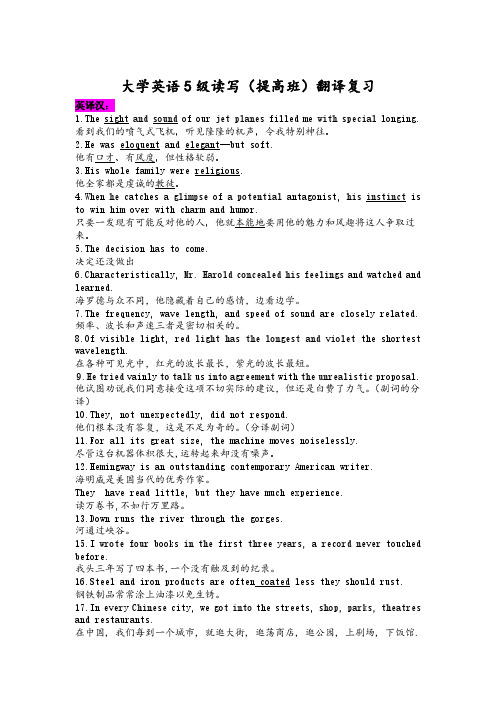
大学英语5级读写(提高班)翻译复习英译汉:1.The sight and sound of our jet planes filled me with special longing.看到我们的喷气式飞机,听见隆隆的机声,令我特别神往。
2.He was eloquent and elegant—but soft.他有口才、有风度,但性格软弱。
3.His whole family were religious.他全家都是虔诚的教徒。
4.When he catches a glimpse of a potential antagonist,his instinct is to win him over with charm and humor.只要一发现有可能反对他的人,他就本能地要用他的魅力和风趣将这人争取过来。
5.The decision has to come.决定还没做出6.Characteristically,Mr.Harold concealed his feelings and watched and learned.海罗德与众不同,他隐藏着自己的感情,边看边学。
7.The frequency,wave length,and speed of sound are closely related.频率、波长和声速三者是密切相关的。
8.Of visible light,red light has the longest and violet the shortest wavelength.在各种可见光中,红光的波长最长,紫光的波长最短。
9.He tried vainly to talk us into agreement with the unrealistic proposal.他试图劝说我们同意接受这项不切实际的建议,但还是白费了力气。
(副词的分译)10.They,not unexpectedly,did not respond.他们根本没有答复,这是不足为奇的。
课文翻译复习资料

UN2Prior to the late 1880s, most of us were so busy trying to make a living that we didn’t care what the Joneses were doing, nor did we know, for that matter. But with the birth of mass media, suddenly we were being told in no uncertain terms that not only were the Joneses far better than we were, but also that we should do something about it. You see, we didn’t know that we weren’t good enough until someone told us. And much of that assessment was, and still is, based on a perceived lack of things we’re told we should want or have. “Fortunately,” those same magazines provided us with ready solutions in the form of advertisements for products that would “catch us up” to the Joneses. Of course, by the time we got there, the Joneses were ahead of us again (kind of like how your brand-new computer is out of date as soon as you walk out of the store) and the vicious cycle of keeping up with the Joneses perpetuated itself and infinitum.19世纪80年代末以前,我们多数人都在忙于生计,既不关心、也不知道邻居们在做些什么。
翻译复习资料
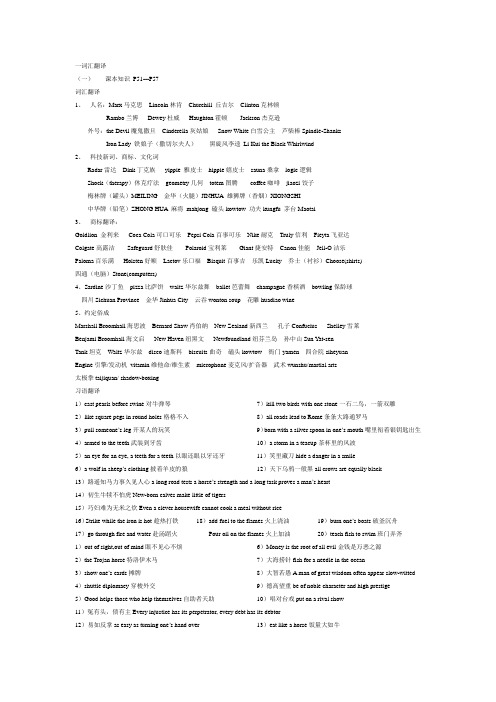
一词汇翻译(一)课本知识P51---P57词汇翻译1、人名:Marx马克思Lincoln林肯Churchill 丘吉尔Clinton克林顿Rambo兰博Dewey杜威Haughton霍顿Jackson杰克逊外号:the Devil魔鬼撒旦Cinderella灰姑娘Snow White白雪公主芦柴棒Spindle-Shanks Iron Lady 铁娘子(撒切尔夫人)黑旋风李逵Li Kui the Black Whirlwind2、科技新词、商标、文化词Radar雷达Dink丁克族yippie 雅皮士hippie嬉皮士sauna桑拿logic逻辑Shock(therapy)休克疗法geometry几何totem图腾coffee咖啡jiaozi饺子梅林牌(罐头)MEILING 金华(火腿)JINHUA 雄狮牌(香烟)XIONGSHI中华牌(铅笔)ZHONG HUA 麻将mahjong 磕头kowtow 功夫kungfu 茅台Maotai3、商标翻译:Goldlion 金利来Coca Cola可口可乐Pepsi Cola百事可乐Nike耐克Truly信利Fieyta飞亚达Colgate高露洁Safeguard舒肤佳Polaroid宝利莱Giant捷安特Canon佳能Jell-O洁乐Paloma百乐满Holsten好顺Lactov乐口福Bisquit百事吉乐凯Lucky 乔士(衬衫)Choose(shirts) 四通(电脑)Stone(computers)4、Sardine沙丁鱼pizza比萨饼waltz华尔兹舞ballet芭蕾舞champagne香槟酒bowling保龄球四川Sichuan Province 金华Jinhua City 云吞wonton soup 花雕huadiao wine5、约定俗成Marshall Broomhall海思波Bernard Shaw肖伯纳New Zealand新西兰孔子Confucius Shelley雪莱Benjami Broomhall海文启New Haven纽黑文Newfoundland纽芬兰岛孙中山Sun Yat-senTank坦克Waltz华尔兹disco迪斯科biscuits曲奇磕头kowtow 衙门yamen 四合院siheyuan Engine引擎/发动机vitamin维他命/维生素microphone麦克风/扩音器武术wunshu/martial arts太极拳taijiquan/ shadow-boxing习语翻译1)cast pearls before swine对牛弹琴2)like square pegs in round holes格格不入3)pull someone’s leg开某人的玩笑4)armed to the teeth武装到牙齿5)an eye for an eye, a teeth for a teeth以眼还眼以牙还牙6)a wolf in sheep’s clothing披着羊皮的狼7)kill two birds with one stone一石二鸟,一箭双雕8)all roads lead to Rome条条大路通罗马9)born with a silver spoon in one’s mouth嘴里衔着银钥匙出生10)a storm in a teacup茶杯里的风波11)笑里藏刀hide a danger in a smile12)天下乌鸦一般黑all crows are equally black13)路遥知马力事久见人心a long road tests a horse’s strength and a long task proves a man’s heart 14)初生牛犊不怕虎New-born calves make little of tigers15)巧妇难为无米之炊Even a clever housewife cannot cook a meal without rice16)Strike while the iron is hot趁热打铁17)go through fire and water赴汤蹈火18)add fuel to the flames火上浇油Pour oil on the flames火上加油19)burn one’s boats破釜沉舟20)teach fish to swim班门弄斧1)out of sight,out of mind眼不见心不烦2)the Trojan horse特洛伊木马3)show one’s cards摊牌4)shuttle diplomacy穿梭外交5)Good helps those who help themselves自助者天助6)Money is the root of all evil金钱是万恶之源7)大海捞针fish for a needle in the ocean8)大智若愚A man of great wisdom often appear slow-witted 9)德高望重be of noble character and high prestige10)唱对台戏put on a rival show11)冤有头,债有主Every injustice has its perpetrator, every debt has its debtor12)易如反掌as easy as turning one’s hand over 13)eat like a horse饭量大如牛14)a flash in the pan昙花一现15)all at sea大海捞针16)Penelope’s web永远完不成的工作17)雪中送炭provide timely help 18)一马当先take the lead19)苦口婆心urge sb. time and again with good intentions 20)退避三舍give way to sb. to avoid a conflict21)星罗棋布spread all over the place(二)课外知识(缩写词)二、句子翻译1. He had enjoyed being outdoors and had reveled in pitting his strength against the forces of nature.他曾喜欢户外活动,醉心于用自己的体力与大自然较量。
文言文翻译英语资料

【原文】夫文言者,古之言语也。
其文简奥,其意深远,非今之言语所能尽也。
故学者必先通其义,而后译之,庶几不失其真。
然翻译之道,非易事也。
须具博学之才,练达之能,方能游刃有余,无遗珠之憾。
【译文】The classical Chinese language, known as文言, is the speech of ancient times. Its writing is concise and profound, and its meaning is profound, which cannot be fully expressed by the modern language. Therefore, scholars must first understand its meaning, and then translate it, so as to preserve its authenticity. However, the art of translation is not an easy task. One must possess a broad range of knowledge and proficient skills to navigate it with ease, without leaving any precious pearls behind.【原文】翻译之法,首在明其字义,次辨其句法,再析其篇章,终通其旨意。
字义不明,则句法错乱;句法错乱,则篇章混乱;篇章混乱,则旨意难明。
故译者宜先详考字义,次则推敲句法,再则整理篇章,最后则揣摩旨意,如此方能译出真谛。
【译文】The method of translation first requires understanding the meaning of each character, followed by distinguishing the syntax, then analyzingthe structure of the passage, and finally comprehending the intent. If the meaning of characters is not clear, the syntax will be confused; if the syntax is confused, the passage will be disorganized; if the passage is disorganized, the intent will be difficult to understand. Therefore, the translator should first carefully study the meanings of characters, then ponder over the syntax, next organize the passage, and finally contemplate the intent. Only in this way can the essence of the text be accurately translated.【原文】翻译之难,在于词句之间。
旅游翻译文件资料
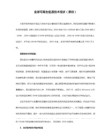
绍兴位于钱塘江南岸, 宁(波) 绍(兴) 平原的西部。土地肥沃, 气候温和, 物产丰富, 素称“鱼米之乡”②。境内河湖纵横密布③, 有“水乡泽国”,“桥都水域”之称。
绍兴是中国著名的历史文化名城, 有着悠久的历史。传说大禹治平洪水后, 曾在此大会诸侯, 死后又葬身这里, 绍兴因此被称为会稽④。春秋战国时(公元前3 世纪) 为越国国都。
美文比读:水乡绍兴
2011-9-22 18:45:19 阅读3 评论0 222011/09 Sept22
水乡绍兴①
2】、国学大师 季羡林 山东聊城人
3】、东营市是山东省省直辖市,与1983年6月成立,是国家规划的黄河三角洲的中心城市,是中国的第二大油田——胜利油田所在地。位于山东省东北部、黄河入海口的三角洲地带,内控黄河、外濒渤海、是环渤海经济圈与黄河经济带的交汇点,具有显著的区位优势。属北温带半温润大陆性气候,四季分明,气温适中,雨热同期,光照充足,既无酷署高寒,又无淫雨干旱。年平均降雨量533毫米,年平均气温12.2摄氏度。
我吐槽她就能毒舌,我面瘫她就能腹黑;
斥退过死皮赖脸的无知青年,躲得了不怀好意的猥琐大叔。[1]
? 北大General Information
? Peking University is a comprehensive and national key university. The campus, known as "Yan Yuan"(the garden of Yan), is situated at Haidian District in the western suburb of Beijing, with a total area of 2,743,532 square metres (or 274 hectares). It stands near to the Yuanmingyuan Garden and the Summer Palace.
成人学位英语考试翻译部分资料
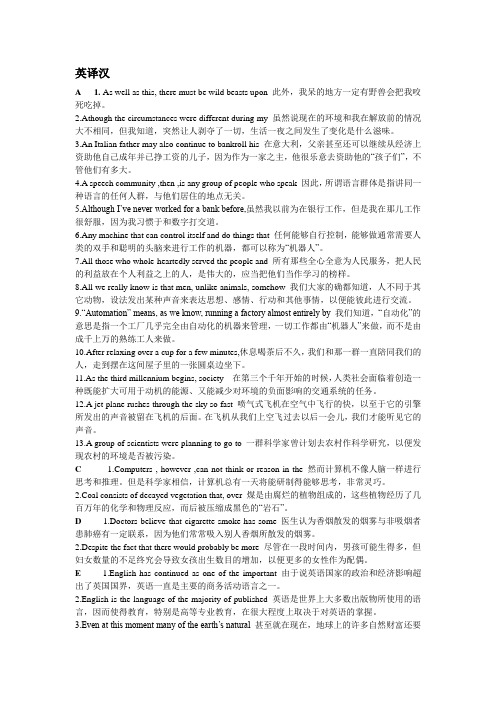
英译汉A 1. As well as this, there must be wild beasts upon 此外,我呆的地方一定有野兽会把我咬死吃掉。
2.Athough the circumstances were different during my 虽然说现在的环境和我在解放前的情况大不相同,但我知道,突然让人剥夺了一切,生活一夜之间发生了变化是什么滋味。
3.An Italian father may also continue to bankroll his 在意大利,父亲甚至还可以继续从经济上资助他自己成年并已挣工资的儿子,因为作为一家之主,他很乐意去资助他的“孩子们”,不管他们有多大。
4.A speech community ,then ,is any group of people who speak 因此,所谓语言群体是指讲同一种语言的任何人群,与他们居住的地点无关。
5.Although I’ve never worked for a bank before,虽然我以前为在银行工作,但是我在那儿工作很舒服,因为我习惯于和数字打交道。
6.Any machine that can control itself and do things that 任何能够自行控制,能够做通常需要人类的双手和聪明的头脑来进行工作的机器,都可以称为“机器人”。
7.All those who whole-heartedly served the people and 所有那些全心全意为人民服务,把人民的利益放在个人利益之上的人,是伟大的,应当把他们当作学习的榜样。
8.All we really know is that men, unlike animals, somehow 我们大家的确都知道,人不同于其它动物,设法发出某种声音来表达思想、感情、行动和其他事情,以便能彼此进行交流。
9.“Automation” means, as we know, running a factory almost entirely by 我们知道,“自动化”的意思是指一个工厂几乎完全由自动化的机器来管理,一切工作都由“机器人”来做,而不是由成千上万的熟练工人来做。
英语翻译复习资料
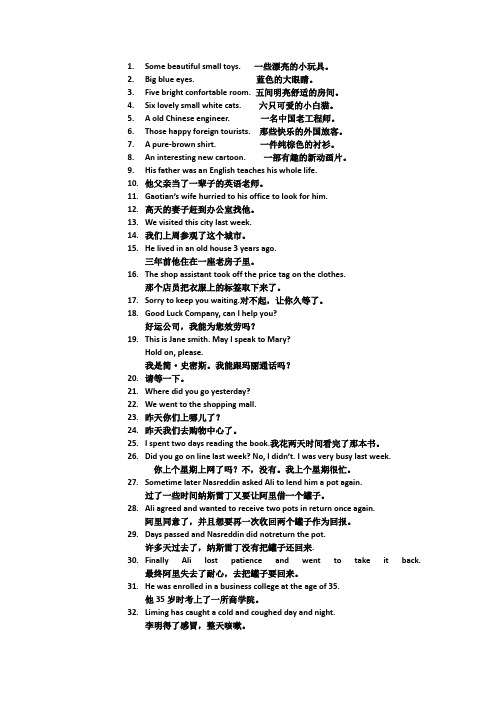
1.Some beautiful small toys.一些漂亮的小玩具。
2.Big blue eyes. 蓝色的大眼睛。
3.Five bright confortable room. 五间明亮舒适的房间。
4.Six lovely small white cats. 六只可爱的小白猫。
5. A old Chineseengineer. 一名中国老工程师。
6.Those happy foreign tourists. 那些快乐的外国旅客。
7. A pure-brown shirt. 一件纯棕色的衬衫。
8.An interesting new cartoon. 一部有趣的新动画片。
9.His father was an Englishteaches his whole life.10.他父亲当了一辈子的英语老师。
11.Gaotian’s wife hurried to his office to look for him.12.高天的妻子赶到办公室找他。
13.We visited this city last week.14.我们上周参观了这个城市。
15.He lived in an old house 3 years ago.三年前他住在一座老房子里。
16.The shop assistant took off the price tag on the clothes.那个店员把衣服上的标签取下来了。
17.Sorry to keep you waiting.对不起,让你久等了。
18.GoodLuck Company, canI help you?好运公司,我能为您效劳吗?19.This is Jane smith. May I speak to Mary?Hold on, please.我是简·史密斯。
我能跟玛丽通话吗?20.请等一下。
21.Where did you go yesterday?22.We went to the shopping mall.23.昨天你们上哪儿了?24.昨天我们去购物中心了。
英译汉翻译资料

2)The synchronous machine as an AC generator driven by a turbine is the device which converts mechanical energy to electrical energy, in powers ranging up to 1500 MW..
3) A static load model expresses the characteristic of the load at any instant of time as algebraic functions of the bus voltage magnitude and frequency at that instant.
形式最简单的换向器由一分为二的滑环组成,每一段在与轴绝缘的同时 也彼此绝缘。
Chapter 10 Instruments and transducers
1) Proper functioning of the system as a whole makes it necessary to monitor conditions existing at many different points on the system in order to assure optimum operation.
翻译复习资料

1. 她对打篮球感兴趣,闲暇时经常打篮球。
She is interested in basketball and often plays it in her spare/free time.2. 约翰上次英语测试没有及格。
John failed his last English examination.3. 已经采取了措施来防止这种流行病H1N1迅速蔓延。
Measures have been taken to prevent the rapid spread of this H1N1 influenza.4. 那名男生在穿过街道时让一辆小公共汽车撞倒了。
The boy was knocked down by a minibus when (he was) crossing the street.5. 这些房子太贵了,没有多少人能买得起。
These houses are so expensive that few people can afford them.6. 商店里四分之三的电视机都是中国制造的。
Three fourths of the TV sets in stores are made in China.7. 她给朋友们看了她所有的照片。
She showed her friends all her photos.8. 下星期将有一场精彩的足球比赛。
There will be a great football match next week.9. 小王在当地公交公司当司机。
Xiao Wang works as a driver in the local public transport company.10. 他今天不能参加我们的聚会了,他在准备明天的考试呢He can not attend/join our party today, because he has to prepare for tomorrow’s test/exam.11. 没有他妻子精心照顾,他活不到今天。
翻译复习资料
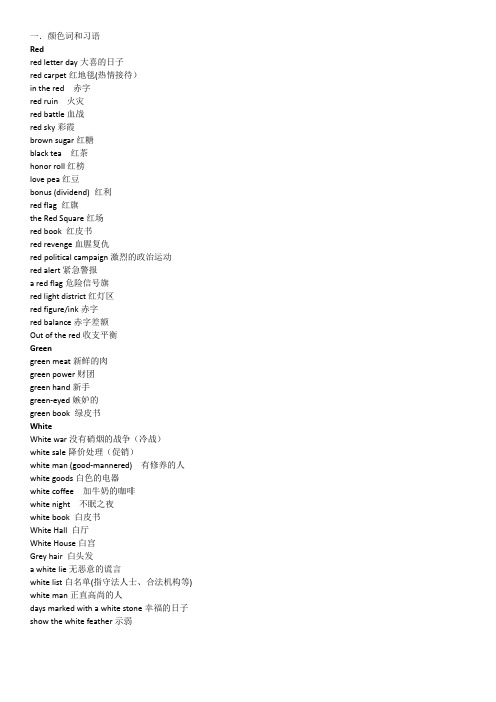
一.颜色词和习语Redred letter day大喜的日子red carpet红地毯(热情接待)in the red 赤字red ruin 火灾red battle血战red sky彩霞brown sugar红糖black tea 红茶honor roll红榜love pea红豆bonus (dividend) 红利red flag 红旗the Red Square红场red book 红皮书red revenge血腥复仇red political campaign激烈的政治运动red alert紧急警报a red flag危险信号旗red light district红灯区red figure/ink赤字red balance赤字差额Out of the red收支平衡Greengreen meat新鲜的肉green power财团green hand新手green-eyed嫉妒的green book 绿皮书WhiteWhite war没有硝烟的战争(冷战)white sale降价处理(促销)white man (good-mannered) 有修养的人white goods白色的电器white coffee 加牛奶的咖啡white night 不眠之夜white book 白皮书White Hall 白厅White House白宫Grey hair 白头发a white lie无恶意的谎言white list白名单(指守法人士、合法机构等) white man正直高尚的人days marked with a white stone幸福的日子show the white feather示弱BlueBlue-eyed boys 社会的宠儿a blue moon 千载难逢的机会blue-sky market露天市场blue sky bargaining胡砍价blue blood高贵血统blue film黄色影片Blue book 蓝皮书Blackblack market地下市场,黑市in the black盈利black art妖术black coffee纯咖啡black Friday耶稣受难日(不吉利的星期五)black words不吉利的话a black letter day凶日a black mark污点yellow pages黄页(指分类电话簿,并非指黄书)black and blue青一块紫一块(而不是青一块黑一块)pink slip解雇职工通知单Idioms1) make pocket call =call sb by accident2) not a through road=dead end 此路不通3) awesome=fantastic, amazing极好的,可怕的4) What are you guys looking for?5) You look like a million dollars today.你今天看起来气色很好Like cures like.以毒攻毒Diamond cut diamond.棋逢对手to call one names 责骂某人in the same boat 同舟共济A stitch in time saves nine.小洞不补,大洞吃苦black sheep 害群之马show the white feathera tall order高标准The Emperor’s new clothesall at sea不知所措直译法1.cold war冷战2.a gentleman's agreement 君子协定3.a barking dog never bites. 吠犬不咬人4.a rolling stone gathers no moss. 滚石不生苔意译法1.to be cat's paws 上当,被人利用2.like a fish out of water 很不自在同义习语套用法1.to laugh off one's head笑掉大牙2.to shed crocodile tears 猫哭老鼠3.to be out at elbows捉襟见肘4.to spend money like water 花钱如流水(挥金如土)5.at sixes and sevens 乱七八糟一、直译加解释法1.There is no rose without a thorn. 世上没有十全的幸福2.The children from well-fed families(good-for-nothing sons and daughter of the idle rich) 膏粱子弟3.Pour water off a steep roof(operate from a strategically advantageous position)高屋建瓴二、直译联想法1.Bad workmen often blame their tools.2.It’s a long lane that has no turning.路必有弯三、意译改造法1.One swallow does not make a summer.一夏不成夏2.No smoke without fire 无火不起烟四、对联增字法1.Ill news comes apace.好事不出门,坏事传千里2.He who keeps company with the wolf will learn to howl.近朱者赤近墨者黑五、等值互借法1.Among the blind the one-eyed man is king.山中无老虎,猴子称霸王2.Great minds think alike.英雄所见略同3.Strike while the iron is hot.趁热打铁4.Like father ,like son.有其父必有其子5.Where there is a will, there is a way.有志者事竟成Idioms 来源I.Bible:1.separate the sheep from goat分辨良莠2. A lion in the way拦路虎3. a fly in the ointment一颗老鼠屎坏了一锅粥4.hole and corner 偷偷摸摸,鬼鬼祟祟5.the apple of the eye掌上明珠6.Hide one’s light under a bushel 不露锋芒7. A dead dog 废物或无价值之物8.Eye for eye, tooth for tooth以眼还眼,以牙还牙9.Between the devil and the deep sea 进退两难10.Escape by the skin of one’s teeth 死里逃生,幸免于难11.Kick against the pricks以卵击石12.No respecter of persons 一视同仁13.Cast pearls before swine 对牛弹琴14.The spirit is willing but the flesh is weak.心有余而力不足II.Shakespeare’s works:1.pound of flesh2.Murder will out (truth will come to light )纸包不住火(真相终将大白)3.Strange bedfellows 同床异梦4.To paint the lily 画蛇添足5.Love is blind. 爱情是盲目的(情人眼里出西施)III.The Fable of Aesop:1.to bell the cat2.One swallow does not make a summer.一燕不成夏3.Blow hot and cold 朝三暮四4.Cry wolf 发假情报(烽火戏诸侯)To add fuel to fire 推波助澜Misfortune never comes single.祸不单行Barking dogs never bite.吠犬不咬人T o laugh off one’s head笑掉大牙A drop in the ocean沧海一粟,九牛一毛To spend money like water花钱如流水There is no smoke without fire.无风不起浪To put on the dog摆架子Every dog has its day. 风水轮流转The longest day must have an end.再难熬的日子也有头(苦难终有尽头)Pull somebody’s leg 愚弄人,开某人的玩笑Move heaven and earth 竭尽全力,不遗余力Child’s play 简单容易Eat one’s words 承认说错了话Dog eat dog 你死我活Throw a sprat to catch a whale 吃小亏占大便宜Give somebody an inch and he will take an ell.得寸进尺Time is money.时间就是金钱,一寸光阴一寸金A contented mind is a perpetual feast.知足常乐Practice makes perfect.熟能生巧Constant dropping wears the stone.滴水穿石You can’t make crab walk straight.江山易改本性难移A word spoken is past recalling.君子一言,驷马难追What you lose on the swings you get back on the roundabouts.失之东隅,收之桑榆A new broom sweeps clean.新官上任三把火One can’t make a silk purse out of a sow’s ear.朽木不可雕Man proposes, God disposes.谋事在人,成事在天Great oaks from little acorns grow.合抱之木,生于毫末Seeing is believing.眼见为实Lookers-on see more than players.当事者迷,旁观者清One is never too late to learn.活到老,学到老The early bird catches the worm.捷足先登,笨鸟先飞You can’t make an omelette without breaking eggs.有失才有得kill the peace. 扼杀和平Admittance Free免票入场No Admittance Except on Business非公莫入Wet (or:Fresh) Paint油漆未干Visitors Declined谢绝参观See to the Fire小心烟火二、翻译1.轻轻地推门进去,什么声息也没有,妻已睡熟好久了.I gently pushed the door in, with quietness all around me. My wife had long fallen fast asleep.2. 沿着荷塘,是一条曲折的小煤屑路。
翻译复习资料

At 60 miles an hour the loudest noise in this new Rolls-Royce comes from the electric clock.时速60英里的新款“劳斯莱斯”轿车,最大的噪音来自车内的电子钟。
“春花”牌吸尘器,清洁地毯、窗帘,还可以吸净象木制和乙烯基一样坚硬的地板,甚至水泥地。
摩力小,噪音低。
请试试吧!你的地板会更加光亮无比。
The Chunhua Vacuum Cleaner cleans rugs and drapes. It cleans hard surface like wood and vinyl floors. Even cement! It is smooth and quiet. Try it and your floors will sparkle with new cleanliness.She is the nimblest girl around. Nimble is the way she goes. Nimble is the bread she eats. Light, delicious, Nimble.她是邻近最敏捷的女孩,敏捷是她的特点。
她只食用“敏捷”牌面包---松软味美的“敏捷”。
We fresh-roast each of our mixed nuts separately---each for the right time, each at the right temperature.我们分别烤制每一份混合果仁,均按合适的温度、恰当的时间加以烘烤。
Xikou Qianceng Cake, with numerous clear sheets in it, is finely made in a traditional way. It is tasty and crisp.溪口千层饼采用传统工艺,制作精细,质地松脆,清香可口。
需要翻译的部分资料

1、 2 STATION THRUST CYL MFD ASSY主推油缸阀块2、SINGLE SHIELD MFD ASSY单护盾阀块3、MFD. ASSY ERECTOR ROTATE管片机旋转单元阀块4、MFD. ASSY. SEGMENT ADVANCE喂片机进给阀块5、HOLDBACK VALVE ASSEMBLY阀块6、TELESCOPIC SHIELD MANIFOLD ASSEMBLY伸缩盾单元阀块7、BACKUP POWER UNIT ASSY后配套液压站8、MANIFOLD MUCK GATE渣斗闸门阀块9、MOUNTING KIT, 2 STATION THRUST MANIFOLD阀块固定件10、REAR SHIELD VALVE RACK后部盾体阀组11、MOUNTING KIT, ARTICULATION/LIFT/TORQUE MANIFOLD阀块固定件12、VALVE ASSY, CH PARK BRAKE刀盘刹车阀组13、GRIPPER LOAD HOLDING MAN.撑靴撑紧阀块14、NEEDLE VALVE, SAE-6调速阀15、WASHER, HIGH COLLAR LOCK M12高强垫片16、WASHER, LOCK M6弹簧垫17、MANIFOLD, HEADER阀块18、HEADER MANIFOLD, 4 STATION阀块19、BALL VALVE, HP SAE-ORB PORTS -08 w/LOCKING DEVICE球阀高压端口,带自锁装置20、FLOW DIVIDER 4-SECTION流量分配阀22、HHCS, M6x40mm C5.6螺栓23、CONVEYOR LIFT MANIFOLD ASSEMBLY皮带机提升阀组24、ARTICULATION/LIFT/TORQUE MANIFOLD绞接,提升,扭矩阀组25、MANIFOLD ASSY, BRIDGE STEERING桥架摆正阀块26、MAIN BEARING LUBE PORT 1 AFT主轴承润滑口27、OUTER SEAL LUBE PORT 1外密封润滑口28、INNER SEAL LUBE PORT 1内密封润滑口29、PINION BEARING LUBE PORT 1小齿轮润滑口30、FORWARD BEARING LUBE PORT 1前部轴承润滑口31、OUTER GREASE FLUSH PORT 1外部润滑脂口32、INNER GREASE FLUSH PORT 1内部润滑脂注入口33、SEAL RING INSPECTION PORT 1密封环检测孔34、BEARING CAVITY DRAIN轴承腔泄油孔35、PINION CAVITY DRAIN齿轮腔泄油孔36、ADAPTER INSPECTION PORT转接座检修孔37、CHDS PRESSURIZATION PORT机头架压力调整孔38、BEARING CAVITY VENT PORT轴承腔通风孔39、SEAL RING INSPECTION SLOT密封不检修窗口40、MAIN BEARING PLUG 1主轴承堵头41、2" SAE 4 BOLT FLG四孔法兰43、FWD SHIELD, FINAL-MACH前盾44、COUPLER导管45、MANIFOLD阀块46、DRAIN PIPE回油管47、PLUG, HEX SOCKET -8 SAE堵头,六角48、O-RING, SIZE 2-338O型圈49、THRUST SHOE WELDMENT推进靴50、THRUST PAD靴底板51、POSITION INDICATING CYLINDER位置监测油缸52、ANTI ROTATION BASE, WELDMENT防转底板53、ANTI ROTATION PLATE防转板54、RESTRAINT, SAFETY CHAIN挡链55、PIN, METRIC销子56、CLAMP RETAINING RING夹紧挡环57、SOCKET CAP, THRUST CYLINDER辅推油缸,球形底座58、CLEVIS吊耳,销子孔板59、TILT SWITCH BOX ASSEMBLY偏转开关装置60、TILT TRANSDUCER, SINGLE AXIS传感器,单轴线61、MOUNTING RING, MUCK CHUTEMOUNTING RING, MUCK CHUTE落料斗固定环62、FLASHING裙板64、FLANGE, TANK 3/4" NPTFLANGE, TANK 3/4" NPT法兰65、AXIAL CARRIAGE ASSEMBLY轴向支架66、RING GEAR TYPE WITH MECHANICAL LIFTING PINS齿圈带轴向起吊销67、YAW CYLINDER调整油缸68、KEYBAR, METRIC销端挡板69、FITTING堵头70、ITEMS分项71、CONVEYOR FRAME, AFT后部皮带机架72、PARTS HIDDEN FOR CLARITY部分部件隐藏以便看清73、ANTI ROTATION BASE, WELDMENT74、SOCKET CAP,球形座75、both sider两侧76、PITCH/ROLL CYLINDERS(齿圈,链条等的)节圆77、YAW CYLINDER偏转油缸78、ENCODER ASSEMBLY编码器79、KEYBAR, METRIC80、GATE闸门81、CABLE, JUMPER, 120VAC, 5ft电缆接线端子82、SPARE MODULE GM40 10-32备用模块83、OUTLET STRIP, 8 SOCKET,US STYLE插座85、carrying training idler从动托锟86、guide roll schedule导向87、impact pan weldment缓冲盘88、plow scraper皮带刮板89、return roll schedule回转90、TAKE-UP FRAME, FWD尾部皮带架91、TAKE-UP FRAME, FWD92、HHCS, M30x100mm C10.9外六角螺栓93、SHCS, M24x80mm C10.9内六角螺栓94、WASHER, HD NW OD M36垫片95、PIN, KEYBAR RETAINED Ø2.5"x6.75" LG销子96、PROX SWITCH接近开关97、PLUMBING, FWD SHIELD & CHDS前盾及机头架布管98、LUG, CONVEYOR吊耳99、DRAIN PLUG, FORWARD SHIELD堵头100、TAP PAD, 16mm THK螺纹底板101、PIPE CAP, 4" BSPT管子螺帽堵头102、TILT SWITCH BOX ASSEMBLY103、TILT TRANSDUCER, SINGLE AXIS104、SAFESET PUMP联轴器加压泵105、TAP PAD, AXIAL CARRIER轴向托架底板107、30" CEMA-C RETURN ROLL托锟108、PIN, KEYBAR RETAINED Ø140mmx280mm LG销子109、BRACKET, GUIDLER支架110、REDUCER, BSHG 08MP-06FP过渡接头111、VALVE BODY, INLINE, T-3A阀块112、12MAORB-12ORB STRAIGHT接头113、ELBOW, 90° STREET 16MP-16FP弯头114、PIPE PORT, O-RING NPT Ø1" C61管接口115、NIPPLE, 1" X 2 1/2" LG接头116、MERCHANT COUPLING, 1" NPT接头117、TEST POINT, SAE测压点118、04FORB- 04MP STRAIGHT接头119、QUICK DISCONNECT (NOSE)快速接头120、QUICK DISCONNECT (BODY)121、QUICK DISCONNECT (CAP)122、SPLIT FLANGE KIT, -20 CODE 61分体法兰123、FITTING, STR 06MORB-06MP接头124、NUT, BHLN Ø1/4"螺母125、FITTING, BHD STR 04FP-04MJ接头126、NIPPLE, HEX 04MP-04MP接头127、FITTING, 04FP-04MBSPP接头。
英语实用翻译期末复习资料
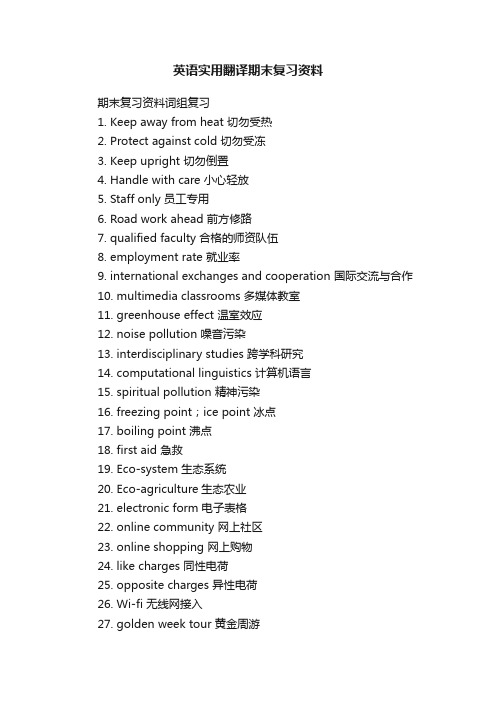
英语实用翻译期末复习资料期末复习资料词组复习1. Keep away from heat 切勿受热2. Protect against cold 切勿受冻3. Keep upright 切勿倒置4. Handle with care 小心轻放5. Staff only 员工专用6. Road work ahead 前方修路7. qualified faculty 合格的师资队伍8. employment rate 就业率9. international exchanges and cooperation 国际交流与合作10. multimedia classrooms 多媒体教室11. greenhouse effect 温室效应12. noise pollution 噪音污染13. interdisciplinary studies 跨学科研究14. computational linguistics 计算机语言15. spiritual pollution 精神污染16. freezing point;ice point 冰点17. boiling point 沸点18. first aid 急救19. Eco-system 生态系统20. Eco-agriculture生态农业21. electronic form 电子表格22. online community 网上社区23. online shopping 网上购物24. like charges 同性电荷25. opposite charges 异性电荷26. Wi-fi 无线网接入27. golden week tour 黄金周游28. cuisine tour 美食游29. suburb tour 郊区游30. check in 入住酒店31. check out 离开酒店32. take-out service 外卖服务33. green hand 菜鸟34. national nature reserve 国家级自然保护区35. information counter 问询处36. duty-free shop 免税店37. non-smoking seat 非吸烟区座位38. scenic spot 风景区39. summer resort 避暑胜地40. historical sites 古迹41. natural landscape 自然风光42. Six Harmonies Pagoda 六和塔43. instant-boiled mutton 涮羊肉44. hot and sour soup 酸辣汤45. fried bread sticks 油条46. 鱼米之乡 land of milk and honey/ land of fish and rice47. 炖牛肉 stewed beef48. 红烧牛肉 braised beef with brown sauce49. Zhejiang Cuisine 浙江菜50. fried rice with eggs 蛋炒饭51. glutinous rice 糯米饭52. spring rolls 春卷53. scrambled eggs 炒蛋54. mineral water 矿泉水55. soybean milk 豆浆56. steamed dumpling 蒸饺57. 孔子 Confucius58. 武术 Wushu(Chinese martial arts)59. 五常:仁、义、理、智、信five constant virtues:benevolence,righteousness,propriety,wisdom and fidelity60. 故宫 the Imperial Palace / the Forbidden City61. 天安门 the Gate of Heavenly Peace62. 三峡 the Three Gorges on the Yangtze63. 二十四节气 the twenty-four solar terms64. 大雪 the Greater Snow65. 冬至 the Winter Solstice66. 《红楼梦》 A Dream in Red Mansions (The Story of the Stone)67. 《三国演义》The Romance of the Three Kingdoms68. 《西游记》Pilgrimage to the West; Journey to the West69. 《易经》 the Book of Changes70. 京剧 Peking Opera71. 五行 Five elements72. 春节 the Spring Festival73. 元宵节 the Lantern Festival74. Research-oriented university 研究型的大学75. 肩负重任 shoulder burdens76. repay society 回报社会77. well-known overseas scholars 知名的海外学者78. 本科生undergraduate79. 高等教育 higher education80. 多民族国家 a multi-ethnic country句子翻译1. Consumer goods are abundant of good quality and variety. 定语,句子结构。
翻译复习资料

翻译复习资料At 60 miles an hour the loudest noise in this new Rolls-Royce comes from the electric clock.时速60英⾥的新款“劳斯莱斯”轿车,最⼤的噪⾳来⾃车内的电⼦钟。
“春花”牌吸尘器,清洁地毯、窗帘,还可以吸净象⽊制和⼄烯基⼀样坚硬的地板,甚⾄⽔泥地。
摩⼒⼩,噪⾳低。
请试试吧!你的地板会更加光亮⽆⽐。
The Chunhua Vacuum Cleaner cleans rugs and drapes. It cleans hard surface like wood and vinyl floors. Even cement! It is smooth and quiet. Try it and your floors will sparkle with new cleanliness.She is the nimblest girl around. Nimble is the way she goes. Nimble is the bread she eats. Light, delicious, Nimble.她是邻近最敏捷的⼥孩,敏捷是她的特点。
她只⾷⽤“敏捷”牌⾯包---松软味美的“敏捷”。
We fresh-roast each of our mixed nuts separately---each for the right time, each at the right temperature.我们分别烤制每⼀份混合果仁,均按合适的温度、恰当的时间加以烘烤。
Xikou Qianceng Cake, with numerous clear sheets in it, is finely made in a traditional way. It is tasty and crisp.溪⼝千层饼采⽤传统⼯艺,制作精细,质地松脆,清⾹可⼝。
翻译复习资料

多义词honor 兑现negotiation 议付confirm (confirmation) 保兑accept 承兑collect 到付clean collection 光票托收cover ①支付、付款给某人;②投保…险,对…保险coverage 保险,险别,投保increasing coverage/extending coverage 加保renewing coverage 续保on or about 前后各5天able and willing 能够并愿意alteration,modification or substitution 更正或修改any and all 任何及所有by and between 由….并在…..之间claim and demand 要求complete and final understanding 全部和最终的理解compensation or damages 补偿或赔偿custom fees and duties 关税covenants and agreements 契约和协议due and payable到期应付的free and clear of无goods and chattels货物与动产losses and damages损失与顺坏made and signed 由……签null and void 无效on and after 在……;在…..之后protect and save 保护及挽救purchase and sell 购买和销售sign and issue 签发terms and conditions 条款therein or thereunder 其中及其下rights and interests 权益Terms:backlog 订单积压futures market 期货市场blank endorsement空白背书negotiating bank议付行CIF到岸价格sight draft即期汇票standby letter of credit备用信用证SWIFT CODE SWIFT代码insurance policy保险单down payment预付款、首付金pro rate of tax 比例税率in lieu of 代替force majeure不可抗力agent ad litem 诉讼代理人per capita按人数,每人Ex Works (named place) 工厂交货(指定地点)多义词A low figure 小数目worker on low incomes 低收入The simplest way to succeed in business is to buy low and sell high. 贱买贵卖The value of the pound has fallen to a new low against the dollar.英镑兑换的比值已跌到新的低点。
- 1、下载文档前请自行甄别文档内容的完整性,平台不提供额外的编辑、内容补充、找答案等附加服务。
- 2、"仅部分预览"的文档,不可在线预览部分如存在完整性等问题,可反馈申请退款(可完整预览的文档不适用该条件!)。
- 3、如文档侵犯您的权益,请联系客服反馈,我们会尽快为您处理(人工客服工作时间:9:00-18:30)。
ABSTRACT
The ever growing traffic explosion in mobile communications has recently drawn increased attention to the large amount of underutilized spectrum in the millimeter-wave frequency bands as a potentially viable solution for achieving tens to hundreds of times more capacity compared to current 4G cellular networks. Historically, mmWave bands were ruled out for cellular usage mainly due to concerns regarding short-range and non-line-of-sight coverage issues. In this article, we present recent results from channel measurement campaigns and the development of advanced algorithms and a prototype, which clearly demonstrate that the mmWave band may indeed be a worthy candidate for next generation (5G) cellular systems. The results of channel measurements carried out in both the United States and Korea are summarized along with the actual free space propagation measurements in an anechoic chamber. Then a novel hybrid beamforming scheme and its link- and system-level simulation results are presented. Finally, recent results from our mmWave prototyping efforts along with indoor and outdoor test results are described to assert the feasibility of mmWave bands for cellular usage.
5G WIRELESS COMMUNICATION SYSTEMS: PROSPECTS AND CHALLENGES
Millimeter-Wave Beamforming as an Enabling Technology for 5G Cellular Communications: Theoretical Feasibility and Prototype Results
INTRODUCTION
The bandwidth-intensive immersive media services that were earlier confined to wired transmission are now making a foray into mobile devices. Video traffic constitutes a significant 51 percent of the mobile traffic volume and is expected to increase to 67 percent by 2017 [1, 2]. Full high definition (Full HD) video is also being increasingly shared through social media such as YouTube, and ultra HD (UHD) and 3D
IEEE Communications Magazine • February 2014
date rapidly increasing traffic demands of the future. Specifically, from the data rate perspective, we expect 5G systems to offer a minimum of 1 Gb/s data rate anywhere to provide a uniform gigabits per second experience to all users, and up to 5 and 50 Gb/s data rates for highmobility and pedestrian users, respectively [3, 4].
video content will eventually take over in the not so distant future.
For the last several years, the telecommunications industry and academia have been investing significant amounts of research effort in fourth generation (4G) Long Term Evolution (LTE) to provide higher data rates to end users by improving spectral efficiency, deploying more base stations, and/or aggregating more spectra. While some of the LTE enhancements, such as advanced multiple-input multiple-output (MIMO), coordinated multipoint (CoMP), heterogeneous networks (HetNets), and carrier aggregation (CA), deliver the additional capacity needed to sustain the traffic surge for the next few years, none of them is seen as a viable solution to support the hundreds of times more traffic demands foreseen in 2020 and beyond, the so-called 5G era.
We also believe 5G systems should be capable of providing significant improvements in cell capacity and boost user data rates to accommo-
106
Hale Waihona Puke 0163-6804/14/$25.00 © 2014 IEEE
The race to search for innovative solutions to enable the 5G era has recently begun worldwide. In early 2013, the European Commission announced that it would invest €50 million in 2013 for 5G research in multiple projects such as METIS, quickly followed by the formation of the Chinese government-led IMT-2020 Promotion Group in February 2013 and the initiation of the Korean government-led 5G Forum in May 2013. While the standardization of 5G specifications in standards bodies such as the Third Generation Partnership Project (3GPP) and the formal ratification of 5G standards by the International Telecommunication Union (ITU) are still several years away, many share the vision that the peak data rate of 5G should be tens of giga-bits per second and offer gigabits per second experience to end users.
